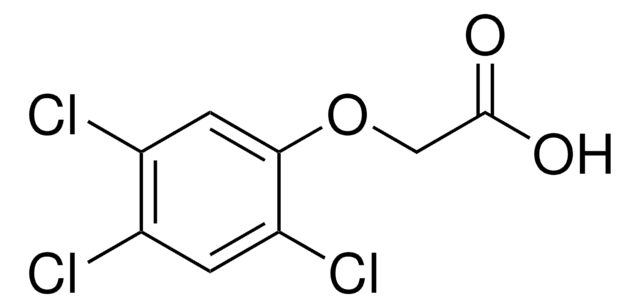T5785
2,4,5-Trichlorophenoxyacetic acid
suitable for plant cell culture, BioReagent, ≥95%, crystalline
Synonym(s):
Trioxone, 2,4,5-T
About This Item
Recommended Products
biological source
synthetic (organic)
product line
BioReagent
Assay
≥95%
form
crystalline
technique(s)
cell culture | plant: suitable
color
off-white to yellow
mp
154-158 °C (lit.)
solubility
5% ethanol: 50, clear to slightly hazy, colorless to faintly yellow
application(s)
agriculture
SMILES string
OC(=O)COc1cc(Cl)c(Cl)cc1Cl
InChI
1S/C8H5Cl3O3/c9-4-1-6(11)7(2-5(4)10)14-3-8(12)13/h1-2H,3H2,(H,12,13)
InChI key
SMYMJHWAQXWPDB-UHFFFAOYSA-N
Gene Information
rat ... Ar(24208)
Looking for similar products? Visit Product Comparison Guide
Application
Biochem/physiol Actions
Preparation Note
Signal Word
Danger
Hazard Statements
Precautionary Statements
Hazard Classifications
Acute Tox. 3 Oral - Acute Tox. 4 Dermal - Aquatic Acute 1 - Aquatic Chronic 1 - Eye Irrit. 2 - Skin Irrit. 2 - STOT SE 3
Target Organs
Respiratory system
Storage Class Code
6.1C - Combustible acute toxic Cat.3 / toxic compounds or compounds which causing chronic effects
WGK
WGK 3
Flash Point(F)
Not applicable
Flash Point(C)
Not applicable
Personal Protective Equipment
Certificates of Analysis (COA)
Search for Certificates of Analysis (COA) by entering the products Lot/Batch Number. Lot and Batch Numbers can be found on a product’s label following the words ‘Lot’ or ‘Batch’.
Already Own This Product?
Find documentation for the products that you have recently purchased in the Document Library.
Customers Also Viewed
Our team of scientists has experience in all areas of research including Life Science, Material Science, Chemical Synthesis, Chromatography, Analytical and many others.
Contact Technical Service









